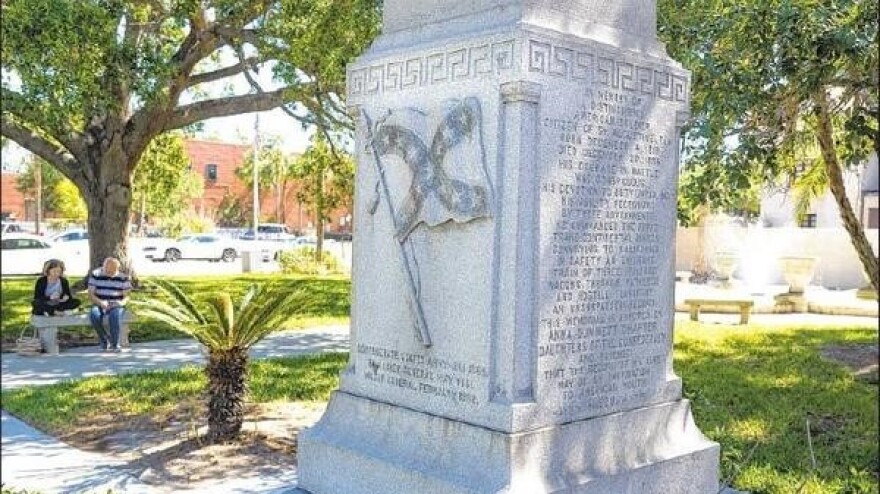St. Augustine activists successfully pushed for the removal of a confederate obelisk from the city plaza this week, and now they’re shifting their full attention to another Confederate monument erected in the city.
Across the street from Flagler College is a monument to William Wing Loring, a former Confederate general.
A difference between the two monuments is who owns them. The city of St. Augustine ultimately controls the fate of the Confederate obelisk, so the City Commission made the decision to relocate it, although to where and when hasn’t been announced yet.
Meanwhile, the Loring monument is managed and preserved by the University of Florida, and its Historic St. Augustine Inc. The state would have the final say on it.
“They need to find a way to remove that monument,” said City Commissioner Nancy Sikes-Kline. “It is clearly a lost cause monument.”
Sikes-Kline was part of the 3-2 vote by the commission to relocate the obelisk the city controls. Two years ago, Sikes-Kline said she had a contrasting opinion on the obelisk, but after listening to diverse groups and doing research herself - including finding out her ancestor listed on the monument owned slaves - her views changed.
“The message is not what I would want to convey,” Sikes-Kline said.
She said she contacted the chair of Historic St. Augustine Inc., Ed Poppell, last year to call for the removal of the Loring monument, but hasn’t gotten an update since then.
Sikes-Kline also said there was some confusion as to whether Loring's remains at the same location as the monument, which would add extra complications for its relocation.
UF announced a multi-step approach to addressing racism and inequities last week. Part of the plan was “removing any monuments or namings that UF can control that celebrate the Confederacy or its leaders.”
In a statement to WJCT News, a UF spokesperson said "University of Florida President Kent Fuchs has stated that he is personally committed to removing any monuments or namings that UF can control that celebrate the Confederacy or its leaders. We believe the Loring monument in St. Augustine falls into that category. We are working with the appropriate parties to find the best path forward."
Marry Cobb, a board member of the Women’s March Alliance of North Florida, has been calling for the Loring monument’s removal for years.
“I can understand why it's there,” Cobb said. “If you look at the [UF Historic St. Augustine Inc.] board, they're all white. They all come from old money. It's not diverse.”
Cobb said when she’s managed to get in touch with the board, they’ve spoken about “contextualizing” the monument, and “adding a memorial for colored soldiers.”
“The solutions that they propose are half-measures,” Cobb said. “They aren’t really delving into the work, because the work is hard.”
Ron Rawls is a pastor at St. Paul AME Church in Lincolnville, a historic district in St. Augustine. He’s been working on the removal of the confederate statues and tackling race issues in the city since 2017.
“We can't have conversations to make our community better as long as symbols of hate are sitting on the table in between us, staring us right in the face,” Rawls said.
The pastor has formed and led protests calling for the city and university to remove these displays from central parts of the city.
He said he’s encouraged by the decision to remove the obelisk, but believes there is still a long way to go.
“St. Augustine is the oldest city in the nation. What that says is that racism is the oldest racism in the nation,” said Rawls.
Rawls collaborated with others in the city to create a list of six changes they want the city to make to improve racial inequalities.
It includes removal of the obelisk, more diversity in the St. Augustine Police Department and city government, body cameras for SAPD, addressing the higher rate of arrest of Black and homeless for minor crimes, and meetings between accountability groups and the city.
With the obelisk gone and St. Augustine Police Chief Barry Fox saying in a June meeting he would consider getting body cameras, Rawls said the list is off to a good start.
“There are no black elected officials in St. Johns County or St. Augustine, no blacks in the top two tiers of leadership in St. Johns County or St. Augustine,” Rawls said. “So we're still a distance away, but at least the people, a few of the people that are up there are understanding that you can't ignore it.”
Sky Lebron can be reached at slebron@wjct.org, 904-358-6319 or on Twitter at @SkylerLebron.





